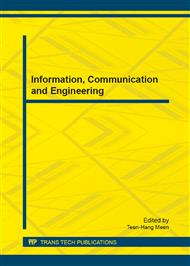[1]
J. K. Gilbert: Visualization, An emergent field of practice and enquiry in science education, in: J. K. Gilbert, M. Reiner, & M. Nakhleh (Eds.), Visualization: Theory and practice in science education, Dordrecht, Springer, 2008, pp.3-24.
DOI: 10.1007/978-1-4020-5267-5_1
Google Scholar
[2]
G. M. Seddon, P. A. Eniaiyeju,. The understanding of pictorial depth cues, and the ability to visualize the rotation of three-dimensional structural formulas in diagrams, Research in Science and Technological Education. 4 (1986) 29-37.
DOI: 10.1080/0263514860040104
Google Scholar
[3]
G. Korakakis, E. A. Pavlatou, J. A. Palyvos, N. Spyrellis, 3D visualization types in multimedia applications for science learning: a case study for 8th grade students in Greece, Computers & Education. 52 (2009) 390-401.
DOI: 10.1016/j.compedu.2008.09.011
Google Scholar
[4]
T. Mayer, Multimedia learning. New York: Cambridge University Press. (2001).
Google Scholar
[5]
K. E. Shubbar, Learning the visualization of rotations in diagrams of three-dimensional structural formulas, Research in Science and Technological Education. 8 (1990) 145-153.
DOI: 10.1080/0263514900080206
Google Scholar
[6]
M. Stieff, Mental rotation and diagrammatic reasoning in science, Learning and Instruction. 17 (2007) 219-234.
DOI: 10.1016/j.learninstruc.2007.01.012
Google Scholar
[7]
J. H. Larkin, J. McDermott, D. P. Simon, H. A. Simon, Expert and novice performance in solving physics problems, Science. 208 (1980) 1335-1342.
DOI: 10.1126/science.208.4450.1335
Google Scholar
[8]
Z. A. Gaál, R. Boha, C. J. Stam, M. Molnár, Age-dependent features of EEG-reactivity—Spectral, complexity, and network characteristics, Neurosci Lett. 479 (2010), 79-84.
DOI: 10.1016/j.neulet.2010.05.037
Google Scholar
[9]
C. J. Stam, M. Breakspear, A.-M. v. C. van Walsum, B. W. van Dijk, Nonlinear synchronization in EEG and whole-head MEG recordings of healthy subjects. Human Brain Mapping, 19 (2003), 63-78.
DOI: 10.1002/hbm.10106
Google Scholar
[10]
C.-F. Huang, C.-J. Liu, An event-related potentials study of mental rotation in identifying chemical structural formulas, European Journal of Educational Research. 1 (2012) 37-54.
DOI: 10.12973/eu-jer.1.1.37
Google Scholar
[11]
F.-M. Kang, C.-L. Chien, Y.-H. Chung, B.-J. Jan, Y.-J. Lu, The study of constructing the norms and web site of spatial ability for industrial vocational high school's students, Journal of Taiwan Normal University: Mathematics & Science Education. 51 (2006) 1-14.
Google Scholar
[12]
T. L. Kelly, The selection of upper and lower groups for the validation of test items, Journal of Educational Psychology. 30 (1939) 17-24.
DOI: 10.1037/h0057123
Google Scholar
[13]
B. Alivisatos, M. Petrides, Functional activation of the human brain during mental rotation, Neuropsychologia. 35 (1997) 111-118.
DOI: 10.1016/s0028-3932(96)00083-8
Google Scholar
[14]
P.L. Ditunno, V.A. Mann, Right hemisphere specialization for mental rotation in normal and brain damaged subjects, Cortex. 26 (1990) 177-188.
DOI: 10.1016/s0010-9452(13)80349-8
Google Scholar
[15]
M. C. Corballis, Mental rotation and the right hemisphere, Brain and Language. 57 (1997) 100-121.
DOI: 10.1006/brln.1997.1835
Google Scholar


